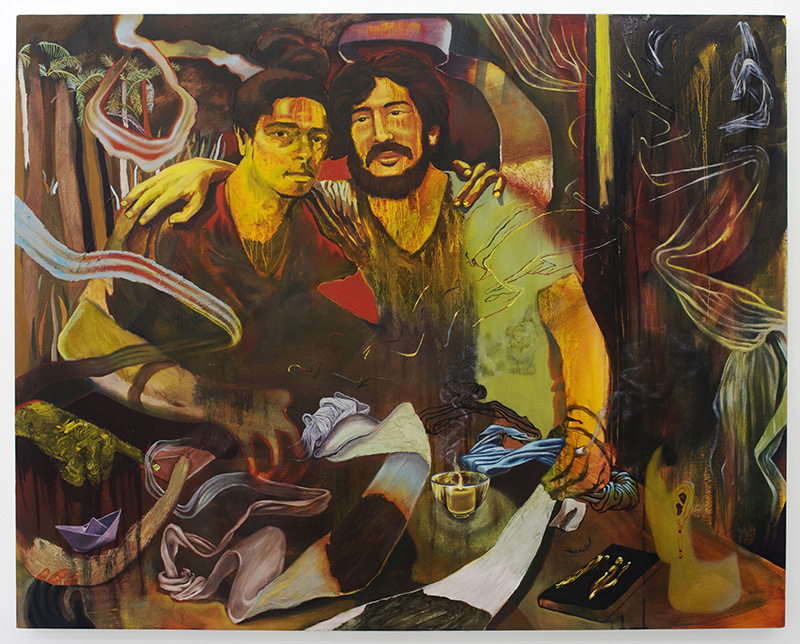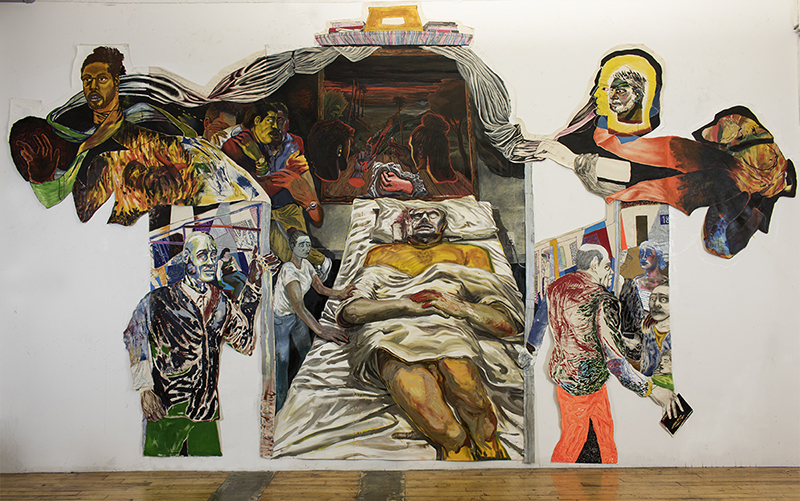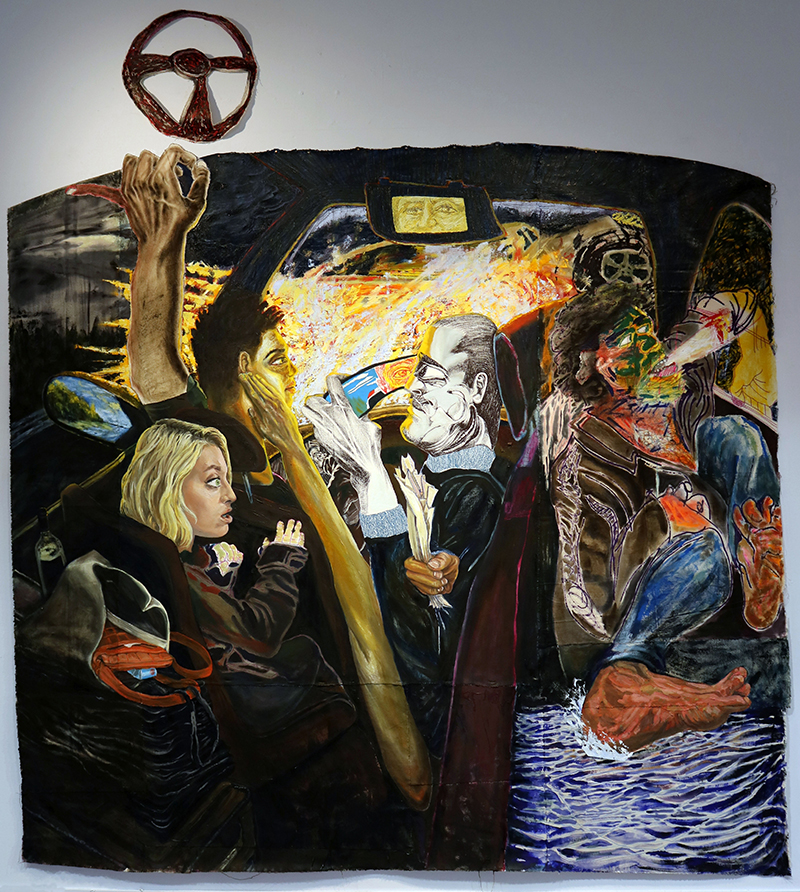I think in making the work I am allowed to explore and create freedoms that do not exist for me in other contexts. To play within and outside of categories or limitations – this freedom is as wonderful as it is terrifying, but it’s important for me to not forget that ultimately I set the stakes as high or low as I want.
Crafting narratives through associative meaning-making helps Erick Alejandro Hernandez refresh perspectives continually.

Take us to the beginning of your story.
Drawing, as a practice, was my companion from very early on in my childhood. I left Cuba at the age of three, due to the political and existential duress my parents were experiencing. After a few years in Lima, Peru, I moved to Miami, Florida, where I spent some of my childhood and my teenage years.
Throughout this period of instability I gradually developed a very serious drawing practice that felt intrinsically linked to processing my experiences. Early on I established a habit of spending many hours a day drawing on sheets of computer paper. I even used to make cut-out figures to play with like toys, modifying them as their characters developed. Thanks to my parent’s strong efforts and access to very good public arts programmes in south Florida, I was able to pursue and value making from a very young age.
Tell us about the evolution of your practice over the years.
Well, what started as an imaginative drawing practice gained some direction as I got older and I started trying to develop my skills in replicating the world around me. In my early teens I was interested in gaining as much skill as possible with the hope of being able to invent my own realities. It didn’t take long for me to transition into a fully fledged painting practice by the time I was in high school. I would get home and paint for hours every day. What was a visceral need to express became more nuanced and conducive to a constant questioning of my existence and the world around me.
In my junior year of high school, a traumatic event changed my practice altogether into a thing of necessity. The act of painting, in both action and duration, became a method to process grief, while the resulting image served as testimony for this process.
Over the years, I have elaborated on this and developed material solutions to generate a lot of space for organic image-making in my practice. Inspired by psychoanalysis and artists like Fred Wilson and Giotto, I have become really invested in crafting narratives through associative meaning-making, which in turn provides me with a continuously refreshed perspective on my experiences and that of those around me.

What were your biggest lessons and hurdles along the way? Which is the most memorable moment?
I think that occasionally I haven’t known how to translate what I am doing into a conducive dialogue with others. And this is something that I have had to work on over time. This protectiveness of my subject matter or incapacity to explain, which is often a result of things still being in a state of development where the right words or insights have yet to unveil, has definitely led to some misunderstandings. A concern of mine has always been to avoid being too specific or didactic, particularly when other’s stories are woven into my work. Ultimately, I think being able to be in a dialogue and be connected with people is incredibly important, and being selective about the right time to do this.
What inspires you? Take us through your process and continuous frameworks of reference.
I try to generate periods where I am very stimulated through movies, books, writing, and seeing a lot of art. Then I filter all these experiences into the studio to get mixed up and reconstituted into something unfamiliar. I’m always inspired by my friends, a lot of them are artists or designers, and music is always present too. I think aside from this, I really enjoy taking the time to talk to the people I come across daily, and cultivate these interactions. Whether it’s the bus driver you see every day or the person you happen to be in the elevator with at some point every week, it’s cool to get a glimpse into what other people’s lives are like and how they view themselves.
How do you balance art and life?
This is something I’m constantly working on and thinking about. Someone once told me they would rather be at the beach thinking about the studio than at the studio thinking about the beach, and this is something I try to remember when I’m being stubborn about leaving my work. Ultimately I believe in having an organic relationship where the studio functions as a space of reflection for your time in the outside world. The studio can also be a place of gathering friends or having conversations in an intimate and vulnerable way.

How do you deal with the conceptual difficulty and uncertainty of creating work?
I think in making the work I am allowed to explore and create freedoms that do not exist for me in other contexts. To play within and outside of categories or limitations – this freedom is as wonderful as it is terrifying, but it’s important for me to not forget that ultimately I set the stakes as high or low as I want. It is good for me to have play in the studio. Also, sometimes it is important to change the album you’re listening to.
What are you looking for when you look at other artists’ work? Who are your maestros?
I look for things that feel honest and unfamiliar regardless of the tradition they may be responding to, and have implications that feel expansive beyond the maker or setting in which they are shown. This is hard to put a value scale to and is subjective to the moment in which you’re exposed to work and what you’re able to take in as an individual on that given day.
More practically, I look for small things: Whether it’s a pushing of paint or the structure of a string of thoughts, I look for insights that could challenge my own work. I’ve had a lot of moments where going to a show, in the same way that reading a book or having a conversation can, really fed into restructuring my practice. I have been really inspired by the narrative solutions in old master fresco cycles, tapestries, and sarcophagi. Recently, I really loved the Charles White Retrospective at the MoMA.
What have you observed in artists in flow?
Some of my best friends and most impactful conversations have their point of origin within a setting where the stakes are rather low. I’ve found that residencies are good for this, but also simple things like a studio visit or getting together in a park. Basically, making space and time to share and listen with no alternative motive. Most of us work really hard, so when those moments come around when people are allowed to shed some of the weight of day-to-day existence and relish in honest communication, it is really refreshing.

What is that one thing you wished people would ask you but never do?
I’d love to participate in or help plan a public mural. I think there is a lot of value in this and love the accessibility of it. It’s important for art to exist outside of institutional confines, and for people to be able to live around it. Also, I think helping to design a stage set could be very cool.
What would advice an artist who is just starting out?
Spend time determining what it is that really drives you to make. Throughout this process, I would say to pay a lot of attention to what others have to say, and be as receptive as possible. That being said, sometimes it is good to be sparing about what makes its way into the work! Honesty is important. So is patience. Sometimes the only way to finish something is by letting it sit in the studio for a long time until the solution comes to you.
What are you working on now? What’s coming next season?
I recently finished a very productive year at the Sharpe-Walentas Studio Program in Brooklyn. For the past few months, I’ve been engaged in collecting and planning for a long-term project that I think will really push how I have structured my work up to now. I don’t want to specify too much because everything is liable to change, but I’m really interested in pushing the immersive potential of my large painting constructions and experimenting with other mediums. Currently, I’m working at a residency in Barcelona called Hangar, and am excited to continue developing this project in 2020 while I’m a fellow at the Corporation of Yaddo, Vermont Studio Center, and The Macdowell Colony.












Add Comment